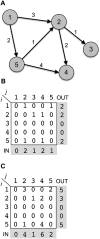Directed networks reveal genomic barriers and DNA repair bypasses to lateral gene transfer among prokaryotes
- PMID: 21270172
- PMCID: PMC3065707
- DOI: 10.1101/gr.115592.110
Directed networks reveal genomic barriers and DNA repair bypasses to lateral gene transfer among prokaryotes
Abstract
Lateral gene transfer (LGT) plays a major role in prokaryote evolution with only a few genes that are resistant to it; yet the nature and magnitude of barriers to lateral transfer are still debated. Here, we implement directed networks to investigate donor-recipient events of recent lateral gene transfer among 657 sequenced prokaryote genomes. For 2,129,548 genes investigated, we detected 446,854 recent lateral gene transfer events through nucleotide pattern analysis. Among these, donor-recipient relationships could be specified through phylogenetic reconstruction for 7% of the pairs, yielding 32,028 polarized recent gene acquisition events, which constitute the edges of our directed networks. We find that the frequency of recent LGT is linearly correlated both with genome sequence similarity and with proteome similarity of donor-recipient pairs. Genome sequence similarity accounts for 25% of the variation in gene-transfer frequency, with proteome similarity adding only 1% to the variability explained. The range of donor-recipient GC content similarity within the network is extremely narrow, with 86% of the LGTs occurring between donor-recipient pairs having ≤5% difference in GC content. Hence, genome sequence similarity and GC content similarity are strong barriers to LGT in prokaryotes. But they are not insurmountable, as we detected 1530 recent transfers between distantly related genomes. The directed network revealed that recipient genomes of distant transfers encode proteins of nonhomologous end-joining (NHEJ; a DNA repair mechanism) far more frequently than the recipient lacking that mechanism. This implicates NHEJ in genes spread across distantly related prokaryotes through bypassing the donor-recipient sequence similarity barrier.
Figures






References
-
- Barabási AL, Albert R, Jeong H 2000. Scale-free characteristics of random networks: the topology of the World-Wide Web. Physica A 281: 69–77
-
- Bassing CH, Alt FW 2004. The cellular response to general and programmed DNA double strand breaks. DNA Repair 3: 781–796 - PubMed
-
- Benjamini Y, Hochberg Y 1995. Controlling the false discovery rate—a practical and powerful approach to multiple testing. J Roy Stat Soc B Met 57: 289–300
Publication types
MeSH terms
Substances
Grants and funding
LinkOut - more resources
Full Text Sources
Molecular Biology Databases
Miscellaneous
